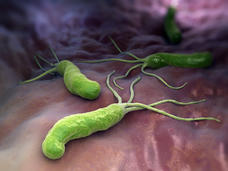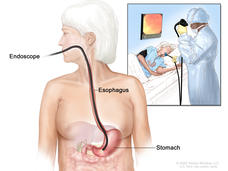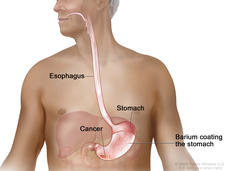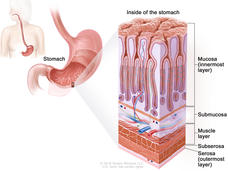What Is Stomach Cancer? (original) (raw)
Anatomy of the digestive tract. The digestive tract is made up of organs that food and liquids travel through when they are swallowed, digested, absorbed, and leave the body as feces. These organs include the mouth, pharynx (throat), esophagus, stomach, small intestine, large intestine, rectum, and anus.
Credit: © Terese Winslow
Stomach (gastric) cancer is cancer that starts in the cells lining the stomach. The stomach is an organ on the left side of the upper abdomen that digests food. The stomach is part of the digestive tract, a series of hollow, muscular organs joined in a long, twisting tube from the mouth to the anus. The digestive tract processes nutrients in foods that are eaten and helps pass waste material out of the body:
- Food moves from the throat to the stomach through a tube called the esophagus.
- After food enters the stomach, it is broken down by stomach muscles that mix the food and liquid with digestive juices.
- After leaving the stomach, partly digested food passes into the small intestine and then into the large intestine.
- The end of the large intestine, called the rectum, stores the waste from the digested food until it is pushed out of the anus during a bowel movement.
Types of stomach cancer
Adenocarcinoma of the stomach begins in the mucus-producing cells in the innermost lining of the stomach. Nearly all stomach cancers are adenocarcinomas.
Adenocarcinoma of the stomach is divided into two main classes, depending on where it forms in the stomach:
- Gastric cardia cancer begins in the top inch of the stomach, just below where it meets the esophagus.
- Non-cardia gastric cancer is cancer that begins in all other sections of the stomach.
Adenocarcinoma of the stomach also may be described as intestinal or diffuse, depending on how the cells look under a microscope:
- Intestinal adenocarcinomas are well differentiated, meaning the cancer cells look similar to normal cells under a microscope.
- Diffuse adenocarcinomas are undifferentiated or poorly differentiated, meaning the cancer cells look different from normal cells under a microscope. Diffuse adenocarcinomas tend to grow and spread more quickly than the intestinal type and be harder to treat.
Gastroesophageal junction adenocarcinoma (GEJ) is a cancer that forms in the area where the esophagus meets the gastric cardia. GEJ may be treated similarly to stomach cancer or esophageal cancer.
Gastrointestinal neuroendocrine tumors are cancers that begin in neuroendocrine cells (a type of cell that is like a nerve cell and a hormone-making cell) that line the gastrointestinal tract. Neuroendocrine cells make hormones that help control digestive juices and the muscles used in moving food through the stomach and intestines. Learn about gastrointestinal neuroendocrine tumors.
Gastrointestinal stromal tumors (GIST) begin in nerve cells that are found in the wall of the stomach and other digestive organs. GIST is a type of soft tissue sarcoma. Learn about gastrointestinal stromal tumors.
Primary gastric lymphoma is a type of non-Hodgkin lymphoma that forms in the stomach. Most primary gastric lymphomas are either mucosa-associated lymphoid tissue (MALT) gastric lymphoma or diffuse large B-cell lymphoma of the stomach.
Rarely, other types of cancer, such as squamous cell carcinoma, small cell carcinoma, and leiomyosarcoma, can also begin in the stomach.
Learn more about stomach cancer
Causes and Risk Factors
The causes of stomach cancer are not known, but there are several risk factors that may increase your chance of stomach cancer.
Symptoms
Symptoms of stomach cancer may include common conditions like indigestion and stomach pain. Learn more to recognize early and advanced stomach cancer symptoms.
Screening
There is no standard screening test for stomach cancer. Learn about tests being studied for stomach cancer screening.
Survival Rates and Prognosis
Learn about stomach cancer survival rates and why this statistic doesn't predict exactly what will happen to you.
Stages
Stage refers to the extent of your cancer, such as how large the tumor is and if it has spread. Learn about stomach cancer stages, an important factor in deciding your treatment plan.
Treating Stomach Cancer
Stomach cancer treatments can include surgery, radiation therapy, chemotherapy, immunotherapy, and more. Learn about the different ways stomach cancer can be treated.
Childhood Stomach Cancer
Childhood stomach cancer is rare. Learn about symptoms and risk factors for stomach cancer in children, and how it is diagnosed and treated.
Coping with Stomach Cancer
Certain aspects of stomach cancer diagnosis and treatment are of special concern. Gain a greater sense of control by knowing what to expect and what resources are available to help you cope.








